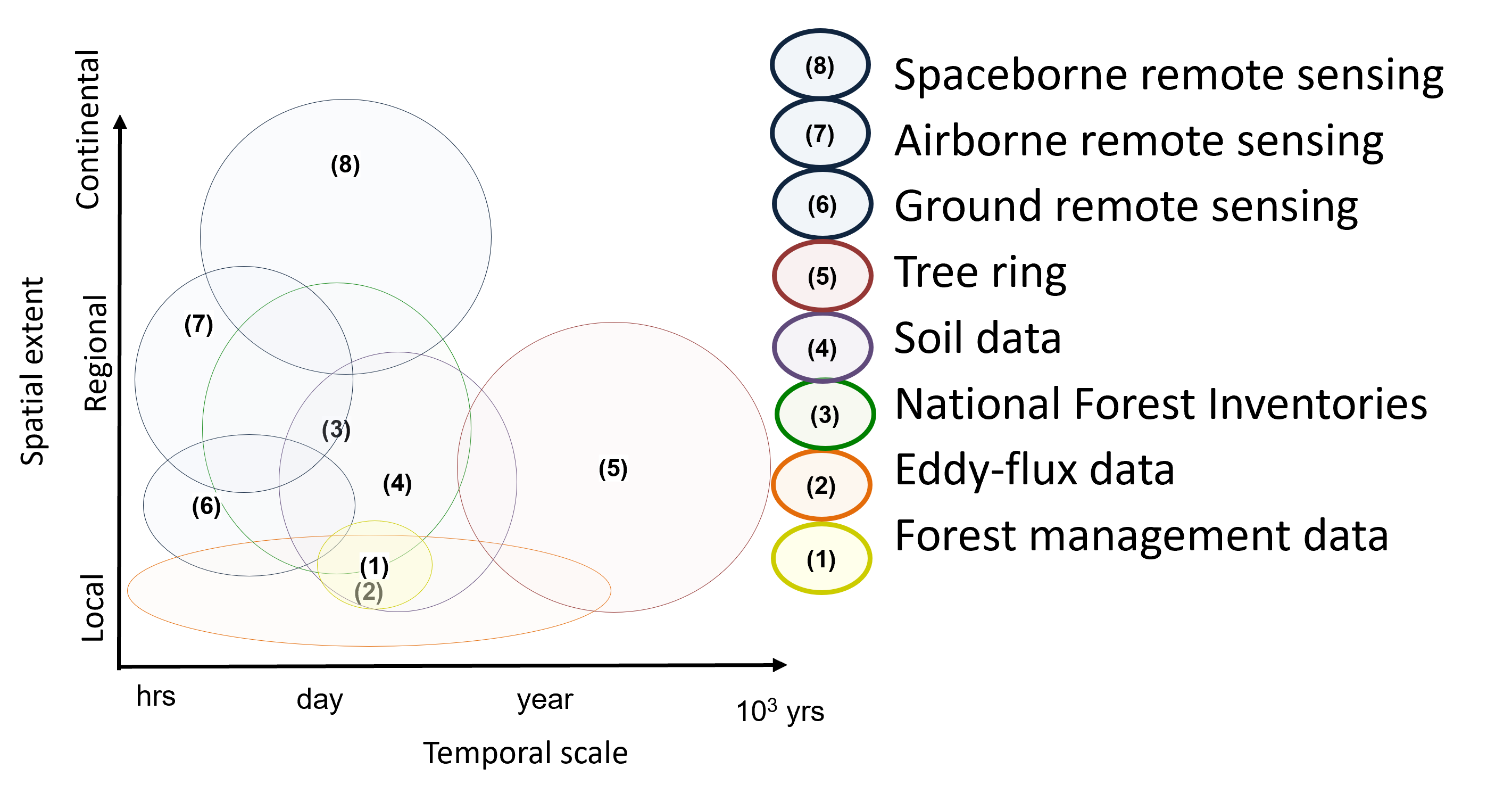Authors: Miguel A. Zavala (University of Alcalá), Ana Rey (National Museum of Natural Sciences and National Spanish Research Council), Tommaso Chiti (University of Tuscia)
Monitoring carbon in forests is essential for climate change mitigation in the context of the European Union’s goal to reach climate neutrality by 2050 and within the framework of the Carbon Removals and Carbon Farming (CRCF) Regulation (EU 2024). Forests, covering nearly 40% of the EU’s land area, act as major sinks by storing carbon in plant biomass and soils. Effective monitoring enables the quantification of carbon sequestration, supports policy development, and ensures the credibility of mitigation (Chiti et al., 2024).
Advancing solutions to address forest carbon monitoring challenges
Carbon in forests is stored in several pools: above-ground biomass (AGB), below-ground biomass, deadwood, litter, and soil organic carbon (SOC). Monitoring efforts must account for changes in all these pools to provide a comprehensive picture of carbon dynamics (Chiti et al., 2024).
Remote sensing technologies, such as satellite imagery and airborne LiDAR, are widely used to estimate AGB biomass. These tools provide high-resolution data on forest structure, including tree height and canopy density, to estimate biomass and carbon stocks (Su et al., 2024). Among different measurements for AGB monitoring, ground-based technologies like terrestrial laser scanning (TLS) offer detailed structural measurements at the plot level and are particularly effective for validating remote sensing data. National forest inventories (NFIs) provide long-term, ground-based data on tree species, diameter, height, and forest structure, which are essential for calibrating models and validating remote sensing outputs. Finally, eddy covariance towers measure carbon dioxide (CO₂), methane (CH₄) and nitrous oxide (N₂O) fluxes at the ecosystem level, offering continuous data on net ecosystem exchange and gross primary productivity. All these approximations are crucial for understanding temporal dynamics and validating model outputs (Chiti et al., 2024).
Soil carbon monitoring remains particularly challenging due to its high spatial variability. It involves repeated soil sampling to assess changes in SOC content, bulk density, and gravel content. Extensive sampling is required for statistically robust estimates, which is both labor intensive and expensive. Recent studies propose a combination of machine learning techniques, in particular, deep neural networks, and satellite imagery to estimate the SOC remotely (Pavlovic et al., 2024) together with mid-infra-red spectroscopy (Li et al. 2023).
Carbon stored in forests is not permanent and can be lost due to disturbances like fire, pests, or harvesting. Besides, leakage, where reduced harvesting in one area leads to increased harvesting elsewhere, can offset carbon gains (Haya et al., 2023).
Models are essential for scaling up observations and for projecting future carbon dynamics. These include empirical models based on forest inventory data, process-based models that simulate carbon flows through photosynthesis and organic matter decomposition, and hybrid models that combine empirical data with mechanistic processes. Forest models allow us to project carbon dynamics over time under different management options and climatic conditions (Gregor et al., 2023).

Key Recommendations
Despite recent advancements, establishing credible baselines to assess additional carbon sequestration from land management practices remains a significant challenge (West et al., 2023). To address this, we recommend the following actions:
- Implement hybrid quantification methods that integrate remote sensing, ground-based data, and modelling to ensure robust and verifiable carbon estimates.
- Standardize methodologies across EU Member States to promote consistency, comparability, and alignment with EU climate targets.
- Support small landowners by developing cost-effective tools, including simplified protocols and mobile applications, to increase participation and data collection.
- Adopt dynamic baselines and temporal accounting to better reflect real-world changes and uncertainties in carbon stocks over time.
- Ensure transparency through open-access data platforms and clear, standardized reporting frameworks to build trust and accountability.
References
Chiti, T., Rey, A., Abildtrup, J., Böttcher, H., Diaci, J., Frings, O., Lehtonen, A., Schindlbacher, A., Zavala, M.A. 2024. Carbon farming in the European forestry sector. From Science to Policy 17. European Forest Institute. https://doi.org/10.36333/fs17
European Union. Regulation (EU) 2024/3012 of the European Parliament and of the Council of 27 November 2024 establishing a Union certification framework for permanent carbon removals, carbon farming and carbon storage in products. Regulation 2024/3012. https://eur-lex.europa.eu/legal-content/EN/TXT/?uri=OJ:L_202403012
Gregor, K.; Krause, A.; Reyer, C.P.O.; et al. Quantifying the impact of key factors on the carbon mitigation potential of managed temperate forests. Carbon Balance and Management 2024, 19, 10. https://doi.org/10.1186/s13021-023-00247-9
Haya, B.K.; Evans, S.; Brown, L.; Bukoski, J.; Butsic, V.; Cabiyo, B.; Jacobson, R.; Kerr, A.; Potts, M.; Sanchez, D.L. Comprehensive Review of Carbon Quantification by Improved Forest Management Offset Protocols. Front. For. Glob. Change 2023, 6, 958879. https://doi.org/10.3389/ffgc.2023.958879
Li, T.; Xia, A.; McLaren, T.I.; Pandey, R.; Xu, Z.; Liu, H.; Manning, S.; Madgett, O.; Duncan, S.; Rasmussen, P.; et al. Preliminary Results in Innovative Solutions for Soil Carbon Estimation: Integrating Remote Sensing, Machine Learning, and Proximal Sensing Spectroscopy. Remote Sens. 2023, 15, 5571. https://doi.org/10.3390/rs15235571
Pavlovic, M.; Ilic, S.; Ralevic, N.; Antonic, N.; Raffa, D.W.; Bandecchi, M.; Culibrk, D. A Deep Learning Approach to Estimate Soil Organic Carbon from Remote Sensing. Remote Sens. 2024, 16, 655. https://doi.org/10.3390/rs16040655
Su, Y.; Schwartz, M.; Fayad, I.; García, M.; Zavala, M.A.; Tijerín-Triviño, J.; Astigarraga, J.; Cruz-Alonso, V.; Liu, S.; Zhang, X.; Chen, S.; Ritter, F.; Besic, N.; d’Aspremont, A.; Ciais, P. Canopy Height and Biomass Distribution across the Forests of Iberian Peninsula. Scientific Data 2025, 12, (678). https://doi.org/10.1038/s41597-025-05021-9
Ruiz-Benito, P., Vacchiano, G., Lines, E. R., et al. 2020. Available and missing data to model the impact of climate change on European forests. Ecological Modelling, 416, 108870. https://doi.org/10.1016/j.ecolmodel.2019.108870
West, T.A.P.; Wunder, S.; Sills, E.O.; et al. Action Needed to Make Carbon Offsets from Forest Conservation Work for Climate Change Mitigation. Science 2023, 381, 873–877. https://doi.org/10.1126/science.ade3535